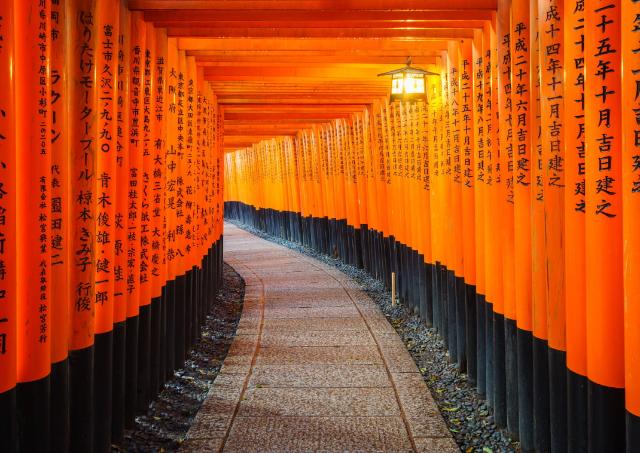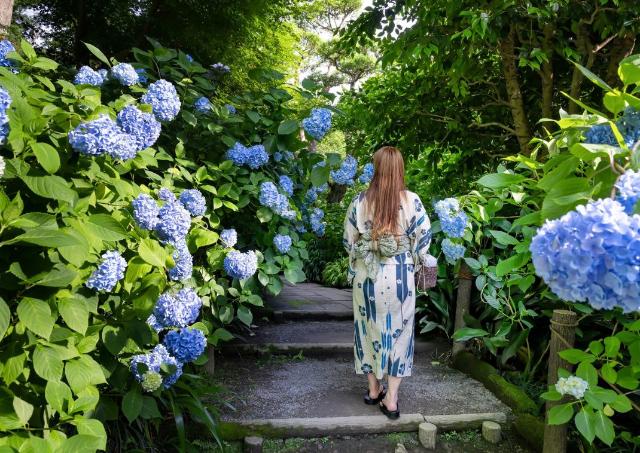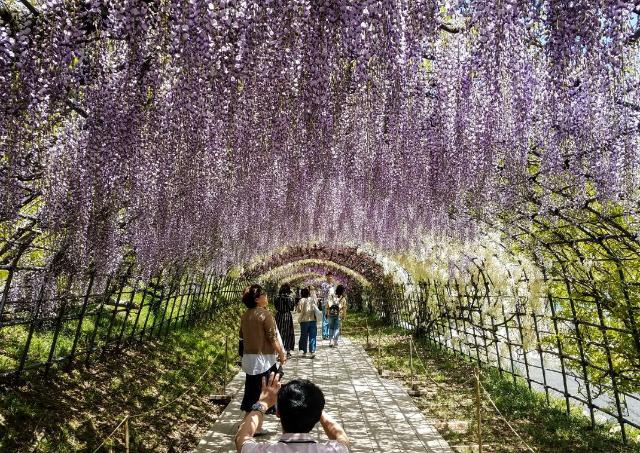Exploring the Endless Green Hills of Active Mt. Aso
Many of the most peaceful places on Earth were formed from immense destruction. Tranquil parks made to commemorate the victims of nuclear blasts, sublime islands made from underwater eruptions, and even bubbling, turquoise crater lakes that remind us that the world continues to change violently even during our own lifetimes. There are few better examples in Japan, and perhaps even on the planet, that summon a feeling of calm and splendour, built from obliteration, as well as stepping into Aso.
Aso City, located in Kumamoto prefecture on western Japan’s Kyushu Island, is a town located in the Aso Caldera. Completely surrounded by mountains, the centrepiece of the caldera is Japan’s largest (not tallest, mind you) active volcano, Mt. Aso. The five peaks of the mountain make up a stunning land formation that is breath-taking from any angle. With its highly active peak, Nakadake, chronically burping smoke from its inner sulfuric blue lake, Aso supplies a great deal of what many tourists come to experience – onsen (hot springs).
However, while the hot springs are a fine enough reason to visit this small volcanic farm town, it’s impossible not to look around from anywhere in Aso and become enthralled by its extreme natural beauty – exemplified by its often emerald-green appearance and watermelon-like hills. If exploring the peaks (each with their own personality) and getting a chance to peer into Nakadake’s bubbling crater isn’t enough, the peace that Aso offers while strolling its famous shrines might transport you to where you want to be. Not forgetting to mention that Aso’s milk is some of the best on the planet (even if you’re not a milk lover, trust us on this).
Let’s get into the details of what makes Aso so particularly amazing.
How to Get to Mt. Aso
Either a bus or train ride from Kumamoto’s capital, Kumamoto City, will get you there. Not far from the prefectural airport, rolling into Aso City is a love at first sight kind of experience. From the surrounding mountains, the whole caldera city can be seen with its massive, multi-teared volcano in the distance. It’s a truly miraculous sight that is often overlooked in international guides. While Aso shows off in any season, Aso’s summer green is particularly remarkable.
The Aso area is made up of Aso City, Minami Aso (southern Aso), and the western side of Takamori. Arriving in Aso Station, the east side houses the Michi no Eki Aso Tourist Information Center where tourists can learn about the area, buy snacks from the local farmer’s market, and try genuine Aso milk – sterilized milk from the local dairy farms of Aso where cows have large areas of land to live happily. The proof is in the taste with this stuff. It really is delicious! Sitting with a cold glass in the dining area offers a relaxing space to view Aso from the window walls. It’s a grand place to start.
Aso Volcano
Without a doubt, the jewel of the area is the volcano. Many of its peaks can be experienced via the bus route to the main sightseeing activity, the Nakadake crater. While several are hikeable, observing these gorgeous mountains from the bus or route area is the way to take them in. Particularly Kusasenri – a peak that sits in front of a large field with a natural risen point for taking in the scenery. It’s worth a few minutes to run around the open area like a kid. For actual children, however, there is a horse-riding zone across from the observation deck building.
Like a great deal of Kumamoto, Aso didn’t escape the terror of Kumamoto’s 2016 mega-quake. While many of the ropeways and historical sites (Aso Shrine, for example) were destroyed, a handful of them have been rebuilt while some public transport systems have been replaced by buses. There’s still a great deal to see and experience and always an efficient way to get there (like most places in Japan).
Nakadake’s cable car system is one of those victims, but a separate bus from the Nakadake Ropeway Station, which still acts as a souvenir shop, regularly hauls tourists to and from the active crater. This is only possible if the sulphur dioxide levels in the area are at a safe level for visiting. The eruption risk level can also be checked here.
Photo: Richard Henry
Assuming they are, visitors will find the walk through the crater area like being on the moon. Massive, once active auburn burnt basins border the now boiling Nakadake sulfuric crater lake – lined with stones turned sulfur-yellow. Looking into the delicate inner earth is like nothing else. While there is always a risk of eruption, tourists will be turned away if the numbers deem it possible. The area is also dotted with emergency bunkers.
The Shrines of Aso
Aso Shrine
A pleasant walk from Miyaji Station, just two stops from Aso Station, Aso Shrine sits at the end of Monzen Machi Shopping Street – a shrine road lined with natural spring waterspouts that many of the shops use to make their own products. What many, after their initial visit, have called Water Street, Monzen Machi is a charming road full of local goods stores that are adorned with wooden waterwheels and moss-covered stones. Taste the groundwater in action at one of the several restaurants and bakeries along the street that get it from the source and use it in the preparing process.
Aso Shrine also uses its own local spring water at its entrance for visitors to cleanse themselves before prayer. Many of the ancient shrine buildings, including the gate, were destroyed in the 2016 quake, but have since been rebuilt with many of the remaining buildings aiming for a late 2023 finish. While the entire site could take much longer, the main hall has since been rebuilt and reconstructed and is a particularly lovely sight. Well over 2,000 years old, people come to the Aso Shrine site to pray for travel safety.
Annual festivals can also be experienced here with Hifuri Festival, referred to as a fire festival, as a particularly popular one. Feel the heat of swinging rope torches on a crisp March night and leave with a blessing for a safe journey ahead. In such a small town, it’s too cool a happening!
Kamishikimi Kumanoimasu Shrine
On the south-east edge of Aso, in Takamori, lies a shrine of significant beauty and perhaps a touch of internet fame. Under the gaze of Mt. Neko (a peak of Mt. Aso that appears to have cat ears), Kamishikimi Kumanoimasu Shrine encompassed by a woodland that is trekked through via steep steps bordered by stone lanterns. It is a rich, forested, emerald wonderland.
Photo: Richard Henry
Known as the setting of the popular anime film, Into the Forest of Fireflies’ Light, the entire experience is mesmerizing from start to finish. From the torii (gate) entrance, an upward glance captures the entire scene. Gate, forest, steps, lanterns, shrine; it’s otherworldly.
Beyond the shrine, the path continues into an enormous rock with an opening in the centre. Touching the rock is said to bring good luck, so many visitors venture past the shrine to give it a high five before leaving. While visiting the shrine itself doesn’t require an entire day, it’s most easily accessed by taking a train or bus to Takamori Station (a rather scenic view along the way) and by taxi from there. While there is an information centre near the station, this part of Kumamoto is quite rural. Expect what comes with being in the middle of nowhere.
Where to Stay
As is assumed, visiting a small town anywhere in the world comes with limited lodging. However, consider the means of stay domestic tourists often use – hot spring resorts. In Aso, there are several of them.
Kurokawa is a name synonymous with rest and relaxation to Kyushu people. From the volcano to the main station, hot springs are plentiful. Traditional or modern, the town around Aso Station encourages explorers of the area to engage in peace of mind.
One of our favourites is Yumeoi-so. A mix of new and old, this resort offers a traditional experience with the convenience that comes with hotel lodging. Yumeoi-so also offers private hot spring baths for couples and families hoping to stay away from the crowds of the public ones. With many outdoor options with views of the volcano as well as wooden baths carved from massive trees, visitors are sure to leave impressed by their experience here. Even for veteran onsen visitors, the Kurokawa area is sure to impress those hoping to relax after a day of trekking and sightseeing.
Ready to roll?
Thinking to add Kyushu to your journey from east Japan? Explore the best parts of the country on our Tokyo, Kyoto and Kyushu Self-Drive tour!
Interested in a hot spring-specific trip? Take a peek at our Nature and Hot Springs tour!




